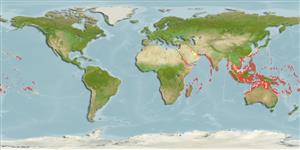Common names from other countries
Environment: milieu / climate zone / depth range / distribution range
Sinh thái học
Biển Cùng sống ở rạn san hô; Mức độ sâu 0 - 60 m (Ref. 128797). Tropical; 35°N - 26°S, 32°E - 122°W
Indo-Pacific: Red Sea, East Africa eastward through northern Australia reaching to Line and Tuamotu islands, north to southern Japan.
Bộ gần gũi / Khối lượng (Trọng lượng) / Age
Maturity: Lm ? range ? - ? cm
Max length : 75.0 cm TL con đực/không giới tính; (Ref. 9710)
Các tia vây lưng cứng (tổng cộng) : 3; Các vây lưng mềm (tổng cộng) : 24 - 26; Tia cứng vây hậu môn: 0; Tia mềm vây hậu môn: 22 - 24. Fish has a deep grove before eye; scaleless area around lips, continuing and narrowing posterior to corner of mouth; small forward-curving spines in about five rows on side of and a short distance anterior to caudal peduncle. Caudal peduncle compressed (Ref. 9770).
Recorded from lagoons, seaward reefs (Ref. 1602) and sheltered inner reef slopes (Ref. 48637). Juveniles often associated with isolated patches of branching coral or rubble of shallow sandy protected areas. Adults occur singly or in pairs on the slopes of deep lagoon or seaward reefs (Ref. 37816, 48637). Often hostile towards divers and may attack unprovoked when caring for eggs (Ref. 48637). Feed on sea urchins, coral, crabs and other crustaceans, mollusks and tube worms. Oviparous (Ref. 205). Largest triggerfish; females are reported to have attacked divers when guarding their nest (Ref. 2334). Also caught with drive-in nets. Marketed fresh and dried-salted (Ref. 9770).
Life cycle and mating behavior
Maturities | Sự tái sinh sản | Spawnings | Egg(s) | Fecundities | Ấu trùng
Distinct paring (Ref. 205).
Matsuura, K., 2001. Balistidae. Triggerfishes. p. 3911-3928. In K.E. Carpenter and V. Niem (eds.) FAO species identification guide for fishery purposes. The living marine resources of the Western Central Pacific. Vol. 6. Bony fishes part 4 (Labridae to Latimeriidae), estuarine crocodiles. FAO, Rome. (Ref. 9770)
IUCN Red List Status (Ref. 130435)
CITES (Ref. 128078)
Not Evaluated
Threat to humans
Reports of ciguatera poisoning (Ref. 1602)
Human uses
Các nghề cá: Tính thương mại
Các công cụ
Special reports
Download XML
Các nguồn internet
Estimates based on models
Preferred temperature (Ref.
115969): 25 - 29, mean 28.1 (based on 1016 cells).
Phylogenetic diversity index (Ref.
82804): PD
50 = 0.7500 [Uniqueness, from 0.5 = low to 2.0 = high].
Bayesian length-weight: a=0.03311 (0.02062 - 0.05319), b=2.97 (2.83 - 3.11), in cm Total Length, based on LWR estimates for this species & (Sub)family-body (Ref.
93245).
Mức dinh dưỡng (Ref.
69278): 3.3 ±0.44 se; based on food items.
Thích nghi nhanh (Ref.
120179): thấp, thời gian nhân đôi của chủng quần tối thiểu là 4.5 - 14 năm (Preliminary K or Fecundity.).
Fishing Vulnerability (Ref.
59153): Moderate to high vulnerability (50 of 100).
